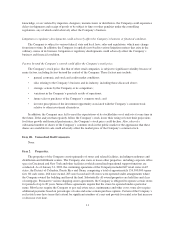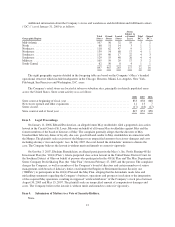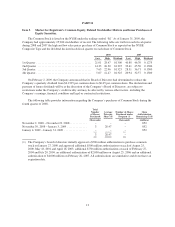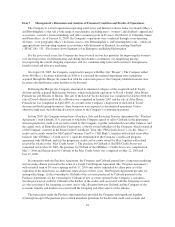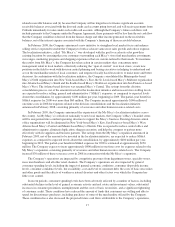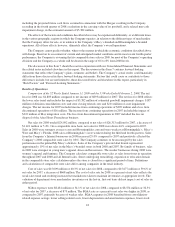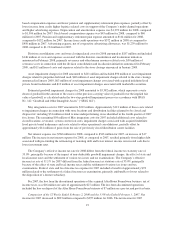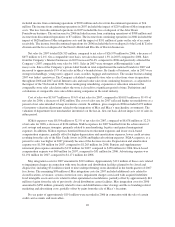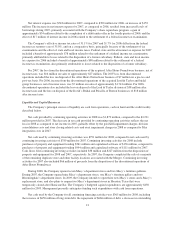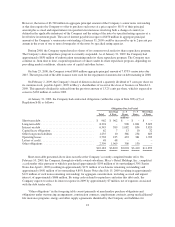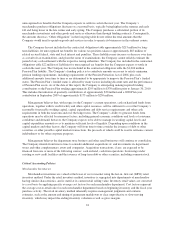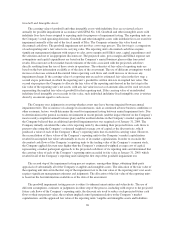Macy's 2008 Annual Report Download - page 23
Download and view the complete annual report
Please find page 23 of the 2008 Macy's annual report below. You can navigate through the pages in the report by either clicking on the pages listed below, or by using the keyword search tool below to find specific information within the annual report.related receivable balances and (ii) because the Company will no longer have to finance significant accounts
receivable balances associated with the divested credit card accounts going forward, and will receive payments from
Citibank immediately for sales under such credit card accounts. Although the Company’s future cash flows will
include payments to the Company under the Program Agreement, these payments will be less than the net cash flow
that the Company would have derived from the finance charge and other income generated on the receivables
balances, net of the interest expense associated with the Company’s financing of these receivable balances.
In February 2008, the Company announced a new initiative to strengthen local market focus and enhance
selling service expected to enable the Company to both accelerate same-store sales growth and reduce expense.
The localization initiative, called “My Macy’s,” was developed with the goal to accelerate sales growth in
existing locations by ensuring that core customers surrounding each Macy’s store find merchandise assortments,
size ranges, marketing programs and shopping experiences that are custom-tailored to their needs. To maximize
the results from My Macy’s, the Company has taken action in certain markets that: concentrate more
management talent in local markets, effectively reducing the “span of control” over local stores; create new
positions in the field to work with division central planning and buying executives in helping to understand and
act on the merchandise needs of local customers; and empower locally based executives to make more and better
decisions. In combination with the localization initiative, the Company consolidated the Minneapolis-based
Macy’s North organization into New York-based Macy’s East, the St. Louis-based Macy’s Midwest organization
into Atlanta-based Macy’s South and the Seattle-based Macy’s Northwest organization into San Francisco-based
Macy’s West. The Atlanta-based division was renamed Macy’s Central. The savings from this division
consolidation process, net of the amount invested in the localization initiative and increased store staffing levels,
are expected to reduce selling, general and administrative (“SG&A”) expenses, as compared to expected levels
absent the consolidation, by approximately $100 million per year, beginning in 2009. The partial-year benefit in
SG&A expenses for 2008 was more than $60 million. The Company incurred approximately $146 million of
one-time costs in 2008 for expenses related to the division consolidations and the localization initiative
announced in February 2008, consisting primarily of severance and other human resource-related costs.
In February 2009, the Company announced the expansion of the My Macy’s localization initiative across
the country. As My Macy’s is rolled out nationally to new local markets, the Company’s Macy’s branded stores
will be reorganized into a unified operating structure to support the Macy’s business. Existing division central
office organizations will be eliminated in New York-based Macy’s East, San Francisco-based Macy’s West,
Atlanta-based Macy’s Central and Miami-based Macy’s Florida. This is expected to reduce central office and
administrative expense, eliminate duplication, sharpen execution, and help the company to partner more
effectively with its suppliers and business partners. The savings from the My Macy’s expansion announced in
February 2009, net of the amount to be invested in the localization initiative, are expected to reduce SG&A
expenses, as compared to expected levels absent the consolidation, by approximately $400 million per year,
beginning in 2010. The partial-year benefit in SG&A expenses for 2009 is estimated at approximately $250
million. The Company expects to incur approximately $400 million in one-time costs for expenses related to the
My Macy’s expansion, consisting primarily of severance and other human resource-related costs. The Company
incurred $30 million of these severance costs in 2008 in connection with the My Macy’s expansion.
The Company’s operations are impacted by competitive pressures from department stores, specialty stores,
mass merchandisers and all other retail channels. The Company’s operations are also impacted by general
consumer spending levels, including the impact of general economic conditions, consumer disposable income
levels, consumer confidence levels, the availability, cost and level of consumer debt, the costs of basic necessities
and other goods and the effects of weather or natural disasters and other factors over which the Company has
little or no control.
In recent periods, consumer spending levels have been adversely affected by a number of factors, including
substantial declines in the level of general economic activity and real estate and investment values, substantial
increases in consumer pessimism, unemployment and the costs of basic necessities, and a significant tightening
of consumer credit. These conditions have reduced the amount of funds that consumers are willing and able to
spend for discretionary purchases, including purchases of some of the merchandise offered by the Company.
These conditions have also decreased the projected future cash flows attributable to the Company’s operations,
17






